A LETTER TO MY IMMIGRANT PARENTS
By Esmeralda Vazquez

GEORGETOWN’S MUSLIM LIFE CREATES HOME ON CAMPUS, 25 YEARS IN THE MAKING
By Angelena Bougiamas
APRIL 26, 2024
NEW GEORGETOWN CLASS NAVIGATES COLLEGE ADMISSIONS IN A POSTAFFIRMATIVE ACTION WORLD
By Aashna Nadarajah
April 26,

4
8 features
‘Georgetown admissions, I think you’re pretentious’: Rural students reflect on application process
KATIE DORAN
features
Georgetown’s Muslim Life creates home on campus, 25 years in the making
ANGELENA BOUGIAMAS
5
sports
Faith, fasting, and football: Muslim student athletes during Ramadan
AMINAH MALIK
6
news
New Georgetown class navigates college admissions in a post-affirmative action world
AASHNA NADARAJAH
7
editorials
As universities clash with student protesters, keep eyes on Gaza
EDITORIAL BOARD
A letter to my immigrant parents
ESMERALDA VAZQUEZ
A gentlewoman’s guide to going out alone
SHANA STRUSKI

12
halftime leisure
3 Body Problem creates harmony from science fiction chaos
ZACH WARREN
13 leisure
Editor-in-Chief ..... Graham Krewinghaus
Editor ..... Ajani Jones internal resources :
Editor for Resources, Diversity, and Inclusion ...... Lukas Soloman
Asst. Editor for Resources, Diversity, and Inclusion ...... Aminah Malik Editor for Sexual Violence Advocacy, Prevention, and Coverage ...... Alison Karki
Service Chair ...... Margaret Hartigan
Social Chairs ...... Bradshaw Cate, Jo Stephens Archivist ...... Megan O’Malley
news :
Executive Editor ...... Amber Xie
Features Editor ...... Eddy Binford-Ross
News Editor ...... Franziska Wild
Asst. News Editors ...... Sydney Carroll, Katie Doran, Aashna Nadarajah
opinion :
Executive Editor ...... Barrett Ahn
Voices Editor ...... Olivia Pozen
Asst. Voices Editors ...... Ali Chaudhry, Alison Karki, Eileen Miller
Editorial Board Chair ...... Sabrina Shaffer
Editorial Board ...... Andrea Ho, Jupiter Huang, Lou Jacquin, Connor Martin, Olivia Pozen, Nora Scully, Lukas Soloman, Dane Tedder, Brandon Wu
leisure :
Executive Editor ...... Zach Warren
Leisure Editor ...... Hailey Wharram
Asst. Leisure Editors ...... Rhea Banerjee, Nikki Farnham, Sofia Kemeny
Halftime Editor ...... Eileen Chen
Asst. Halftime Editors ...... Gabriel Mendoza, Sagun Shrestha, Francesca Theofilou
sports :
Executive Editor ...... Jo Stephens
Dancing the night away to banda and corridos, Ballet Folklórico Mexicano de Georgetown brings brilliance to the student dance community
SOFIA KEMENY
14
halftime sports
The state of sports betting
BRADSHAW CATE, ANDREW SWANK, JO STEPHENS, AND ANNA CORDOVA on the cover
“Subsurface Scatterings"
BAHAR HASSANTASH
Tune in to podcasts...
On this episode of Post Pitch, listen to Voices’ Esmeralda Vazquez discuss her piece “A letter to my immigrant parents” with Podcast Executive Producer Romy Abu-Fadel, using the QR code:
Barry and Sow found strong support from their non-Muslim teammates and coaching sta , recounting genuine care and concern from them. “My teammates were really understanding,” Barry said. “They would pour water down my back just to help me cool down.”
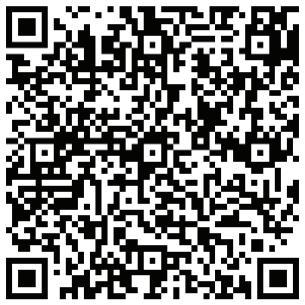
Sports Editor ...... Henry Skarecky
Asst. Sports Editors ...... Ben Jakabcsin, Langston Lee, Andrew Swank
Halftime Editor ...... Bradshaw Cate
Asst. Halftime Editors ...... Andrew Arnold, Anna Cordova, Sam Lynch
design : Executive Editor ...... Grace Nuri
Design Editor ...... Tina Solki
Spread Editors ...... Olivia Li, Pia Cruz
Cover Editor ...... Bahar Hassantash Asst. Design Editors ...... Elin Choe, Madeline Jones, Rachel Zhang
copy:
Copy Chief ...... Cole Kindiger
Asst. Copy Editors ...... Maanasi Chintamani, Rania Khan, Isabel Shepherd
multimedia :
Multimedia Executive ...... Connor Martin
Podcast Executive Producer ...... Romy Abu-Fadel
Podcast Editor ...... Lucy Collins
Photo Editor ...... Izzy Wagener
online : Online Executive ...... Tyler Salensky
Website Editor ...... Mj Morales
Social Media Editor ...... Kristy Li
Asst. Social Media Editor ...... Mark Manaois
business :
General Manager ...... Rovi Yu
Asst. Manager of Accounts and Sales ...... Mini Xue
Asst. Manager of Alumni and Outreach ...... Ninabella Arlis
support :
Contributing Editors ...... Adora Adeyemi, Angelena Bougiamas, Lou Jacquin, Lucie Peyrebrune, Nora Scully
Associate Editor ...... Jack Kealey
Staff Contributors ...... Meriam Ahmad, Carolina Bomeny, Mia Boykin, Elyza Bruce, Emma Cameron, Elspeth Campbell, Romita Chattaraj, Leon Cheung, Dolce Coury, Yihan Deng, Ryan Goodwin, Paul Kang, Julia Kelly, Ashley Kulberg, Imani Liburd, Nicholas Romero, Carlos Rueda, Isabella Stratta, Kami Steffenauer, Amelia Wanamaker, Jihoo Yang, Nadine Zakheim
11 voices
10 voices
PG 5 2 THE GEORGETOWN VOICE Contents contact us editor@georgetownvoice.com Leavey 424 Box 571066 Georgetown University 3700 O St. NW Washington, DC 20057
The opinions expressed in The Georgetown Voice do not necessarily represent the views of the administration, faculty, or students of Georgetown University, unless specifically stated. Columns, advertisements, cartoons, and opinion pieces do not necessarily reflect the views of the Editorial Board or the General Board of The Georgetown Voice. The university subscribes to the principle of responsible freedom of expression of its student editors. All materials copyright The Georgetown Voice unless otherwise indicated.
2024 Volume 56 | Issue 14
Managing
Executive
An eclectic collection of jokes, puns, doodles, playlists, and news clips from the collective mind of the Voice sta

Aries, you may find one of the secret entrances to the underground tunnels and be tempted to explore. Do not enter

“Go shawty, it’s ya birthday, We gon party like it’s ya birthday.” Lovely Tauruses, 50 Cent is right on the money—your birthday season is in full swing, and it’s time to let the festivities commence!

Gemini, give yourself a well-deserved break from the drama you’ve had this semester; we know how that one person made you feel about that one thing. You did not deserve that.

Cancer, while your friends love your loyalty and dependability, it’s not your job to fix them—the last thing anyone wants while puking off the side of Vil A is a lecture on making good choices.

Please, Leo, for the love of all things on this side of the Potomac, don’t stir up that last-minute drama you’ve been eyeing; in fact, maybe stay far, far away.

This Georgetown Day, Virgo, I want you to throw caution to the wind. Throw your phone into the river. Throw a rock through a window. Throw up off a balcony.

Libra, don’t be afraid to dance when
“Low” comes on, to put glitter on your eyelids, to let out your inner yapper—I promise, we’ll still think you’re cool and mysterious when Saturday comes around.

Scorpio, not everyone screaming “Love Story” in your ear is your soulmate, and if he has a perm and a silver chain, you probably can’t fix him.

Do what makes you happy this Georgetown Day, Sagittarius. Be confident in your choices and don’t let the haters get you down. John Caroll wouldn’t want that for you.

The stars are aligning for you to start beef with all your friends, Capricorn; it’s nearly the end of the semester anyway, so who cares if you burn bridges!
→ GRAHAM'S CROSSWORD

Relax, Aquarius. Go where the river takes you. Your one goal for the day: get on the Vil-A rooftop without GUPD stopping you. Every dam will eventually break.

Pisces, you know you're going to get misty about the end of the semester—make sure you have a supportive shoulder (a friend, not a situationship) and plenty of liquids (alcoholic or otherwise) as those tears keep coming.
Check out our exteneded hoyascopes through the QR code below. Have a happy Georgetown Day!

As we wrap up the semester, my last as an editor for the Voice, I’m feeling a lot of things, but above all, gratitude. Gratitude for my fellow editors and friends at the Voice, who have defined my Georgetown experience. Gratitude for those we’ve covered, who have kept our jobs interesting and fulfilling. And gratitude for our readers, who (I hope) engage positively with our writing and agonize over our crosswords. Of the latter, I leave you with one of my favorites I’ve made. Enjoy! — Graham

→ PIA’S JAUNTY, JUFF, JOCULAR, JUBILANT JAMWICH

ACROSS:
1. Cast that’s great for people who love hearing themselves talk
4. Notorious ___, “Juicy” artist
7. Dunkable delight, maybe Double Stuf’d
11. Litigated, as a prosecutor
13. Praiseful poem
14. Sacred images (var.)
15. **With 35- and 57-Across, one of hip hop’s most iconic opening lines
18. String instrument formed by beheading wind instrument?
19. Class of constrictor
20. Swab the deck
22. Dome
25. No. on a business card
26. No. on a business’ cornerstone
27. Feeble, unimposing
28. First syllables of McDonald’s jingle
29. Nile queen, familiarly
30. Letters found in appropriate, appropriately?
31. Segment of an army
33. Litigate, as a judge
35. **See 15-Across
39. Q’s neighbor to the west
40. Pringles competitor
41. Volcanic output
44. Java joint
47. PC operator
49. Ike’s compatriot
50. Pennsylvania or Wisconsin, in D.C.
51. What one might’ve done to a horse with respect to water, only to find it won’t drink
52. Mirage, mistakenly
53. Doze (off )
54. A deer, a female deer
55. What one might do to the seas, or one’s hair
57. **See 15-Across
63. What lengths and widths multiply for 64. Not 24-Down
65. Kiln
66. Tramp companion in a Disney classic
Witch, shrew
Nevertheless
DOWN:
1. Pressure measure, for short
2. ___ and about
3. Dawn drops on the lawn
4. Kodak Black: “Lemme drive the ____”
5. Loiter
6. Firm up, as a group or a hairdo
7. Gumbo vegetable
8. ___ v. Wade
9. Tooth covering
10. What one might be trying to do with a textbook under the pillow
12. Loiter, with “dilly”
Second Commandment no-no
16. “How's it going?”
17. Troy’s companion, famously in the
Salaried sick leave, for short
Spot with many a cucumber slice
With “I,” what one shouldn't spell on the playground
Not 64-Across
Told Mom, maybe
Auction action
’Til later, in text
Well-known locale for a Miley Cyrus party
Vague, hard to pin down
Drops of golden sun
Salt Lake City
need
“For ___ a jolly good fellow”
e.g.
Felt hat for a Jones
page six graphic by olivia li ; crossword by graham krewinghaus ; “ pia’s jaunty, juff, jocular, jubilant jamwich ” by pia cruz; layout by tina solki
68.
67.
14.
morning 21.
22.
23.
24.
25.
28.
29.
31.
32.
34.
36.
collegiate
37. Rowing
38. Place
speak 42. Hit the
43.
44. Fire 45.
46.
or
48. Trickle, percolate 49. Unleavened bread for Passover 52. Singer Rita 54. 1944 Normandy event 55. Legal prefix 56. Frenzied,
58. Swift album 59. Speedometer stat, stateside 60. Wall-climbing tradition in a certain league 61. Word preceding a maiden name 62. Doc for sinusitis → HOYASCOPES FOR GEORGETOWN
athlete
to stand and
slopes
“I do,”
a Tracy
gung-ho
DAY!
3 APRIL 26, 2024 Page
3
Georgetown’s Muslim Life creates home on campus, 25 years in the making
 BY ANGELENA BOUGIAMAS
BY ANGELENA BOUGIAMAS
When Janeeta Shaukat (SOH ’24) came to Georgetown, she began to wonder if God existed. Although she was born in a Muslim family, she had yet to deeply explore her faith.
Like many students, she faced big questions about her place as a first-generation and low-income student at a school where 74% of students come from the top 20% of earners. She also wrestled with her place in the world, living in the United States while territorial and religious conflict plagued her family’s homeland, Kashmir.
When she turned to religion for answers, it was Georgetown’s Muslim Life that brought her closer to Islam—and it was Islam that brought her peace.
“Through this community, which is very strong, I was able to build that connection with God,” Shaukat said. “I feel like sometimes I don't know where I would be if Muslim Life didn't catch me at the right time.”
Muslim Life is one of six faith traditions supported by the Georgetown Office of Campus Ministry—a product of Georgetown’s emphasis on interreligious understanding. They host retreats, social events, and daily prayer services that are supported by student fellows and student-run community groups, like the Muslim Student Association.
Shaukat originally sought out the branch of Campus Ministry after growing curious about Islam as a support system and wanting to learn more about its five pillars, including prayer. Looking for guidance, she reached out to Muslim Life Director Imam Yahya Hendi.
Hendi, who became the first full-time Muslim chaplain at a U.S. university when Georgetown hired him in 1999, spends much of his time advising students like Shaukat when he’s not leading religious services or spearheading community programming.
“It was not easy to start something brand new from nothing,” Hendi said. “I learned from my brothers and sisters in other faith communities, how they do chaplaincy on campuses, and I built something from nothing.”
In his first year at Georgetown, during Ramadan, the Muslim holy month observed through fasting, prayer, and reflection, Hendi hosted an on-campus iftar, the meal eaten at sunset to break the daily fast. Around 20 undergraduate and graduate students attended.
Twenty-five years later, on April 2, the first University Ramadan Celebration and Iftar took place in Leavey Ballroom, based on Muslim Life’s yearly “Fast-a-Thon,” where non-Muslims were invited to

fast alongside Muslim community members and share an iftar together. More than 400 attended, and it included a presentation explaining Ramadan’s significance alongside speeches by President John DeGioia, representatives from different campus faith groups, and university officials.
Members of Georgetown’s Muslim community, along with non-Muslim guests, broke their fasts with dates and water after a reminder by Hendi to give food to others before helping themselves.
For Muslim Resident Minister Iman Saymeh, the wide range of diverse backgrounds at the iftar gave her hope.
“They didn't have to come and wait for the call of prayer,” she said. “They didn't have to come and wait for all this time, but they did. And that really assures me that there is hope for the future, for humanity to come together even more.”
The iftar’s organizers facilitated fundraising for Life for Relief, an organization bringing humanitarian aid to areas including Gaza, which is on the brink of famine due to restrictions on aid by Israel.
This fundraising aligns with the emphasis put on charity during Ramadan and connects to a core tenet of Hendi’s philosophy: “radical passion for compassion.” As Georgetown’s imam, Hendi has promoted social justice causes at home and abroad, and is committed to interreligious dialogue.
“I feel like without a lot of the work he's done, there could be more tension between Christians, Jews, and Muslims on campus because of the global climate,” Shaukat said. “But he continues to create spaces where students can come together as students and really talk to each other about religion.”
Hendi has also sought to instill a culture of care for others in students, aiming to make Georgetown’s Muslim community one where anyone can participate.
“We are better at what we do if we can build a strong community where everyone feels at home, where no one feels excluded, no one feels judged,” he said.
Beyond cultivating a vibrant community, Hendi has spearheaded other initiatives to help make the Hilltop feel like home for Muslim students. He worked with dining hall management to bring halal food options to campus starting in 2016. Last December, Hendi also brought 25 students on a trip to Mecca to complete an Islamic pilgrimage, while simultaneously fundraising
nearly $100,000 to make the event accessible to all.
Last March, Georgetown also inaugurated the Yarrow Mamout Masjid, a mosque with a halal kitchen, a spirituality and formation hall, and an ablution station used for Wudu religious ritual of washing before prayer. Before its construction, students prayed in the Copley basement, which was too small even in 1999. Hendi fundraised around $1.4 million over the last 12 years to fund the Masjid, collaborating with university staff
For him, all this work feels necessary.
“Muslim students wanted to feel at home,” he said. “You feel at home when you feel welcomed, accommodated, and when you feel that this home really cares about providing you with the space of being at home.”
As the Georgetown Muslim community grows in size, Hendi will continue to build out Muslim Life’s programming. He is considering adding an extra Friday prayer service to accommodate everyone who wants to attend and said that the community is empowered by its growth.

“It's 25 years that went gradually, slowly, but surely,” he said. “Engaging the full community, the larger community, the small community, to have them feel at home in every way that we could, the kind of programs we organized and we continue to organize is quite

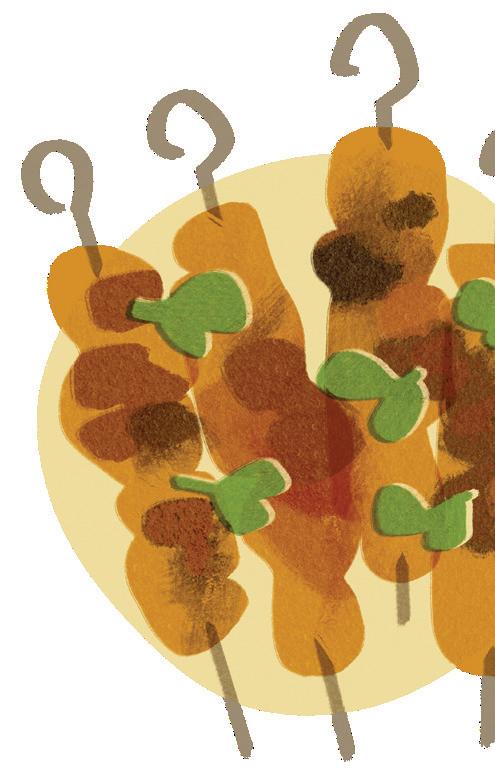





FEATURES THE GEORGETOWN VOICE 4 design by pia cruz


Faith, fasting, and football: Muslim student athletes during Ramadan
BY AMINAH MALIK
On April 10, Muslims around the world celebrated Eid, the holiday that marks the conclusion of the holy month of Ramadan. Ramadan, the ninth month in the Islamic calendar, is marked by the practice of fasting daily from dawn until dusk and is meant to bring Muslims closer to God through the practice of self-restraint, patience, and the cultivation of gratitude.
While fasting, Muslim students experience a complete reworking of their habits and sleep schedules during Ramadan. Fatigue from fasting also makes it challenging to stay alert and focused, making attending class and completing assignments a struggle. When sports are thrown into the mix, there are additional challenges. The Voice sat down with two Muslim athletes on the football team, sophomore cornerback Alpha Barry and freshman defensive tackle Mouhammed Sow, to learn about their Georgetown athletic experience during Ramadan.
A primary struggle of theirs throughout the month was battling dehydration and fatigue during workouts. “Only having a small frame to hydrate from, like, the time we can [drink] to the time I go to bed, it’s not a lot to work with, especially with the amount of water we’re losing during our workouts and practice,” Sow said.
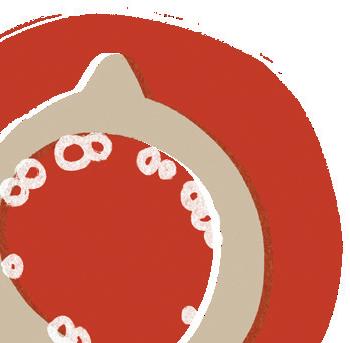

According to them, early morning practices were helpful in addressing this. “Everything’s usually in the morning, that’s what makes it easier,” Sow said, explaining that practices immediately after the pre-fasting meal (suhoor) were more manageable, as energy and hydration levels would be high.
When asked if there was any way Ramadan could be made easier for student athletes, Barry and Sow were honest about the realities of fasting and sports.
“You have to remember, you are a part of the team, and you have your responsibilities to the team,” Barry said. “[Even while fasting,] you’re still a team member and you’re expected to do what everyone else is doing.”
For Muslims, Ramadan is a markedly social experience. Meals for beginning and breaking the fast, suhoor and iftar, in addition to special Ramadan prayers made in congregation, facilitate more community gatherings than usual. During the month, Muslims are also joined by their shared fasting experience in a larger non-Muslim society. For student athletes, this shared experience is especially valuable to overcome the physical demands of athletics.
“Tuning into the NBA, watching Kyrie Irving have his best games during Ramadan, I go to workouts [in the morning and] I just know I gotta push the best I can, for real,” Sow said.
Muslim unity during Ramadan is crucial to surviving the month and its challenges in a nonMuslim society. But Barry and Sow also found strong support from their non-Muslim teammates and coaching staff, recounting genuine care and concern from them. “My teammates were really understanding,” Barry said. “They would pour water down my back just to help me cool down.”

At Georgetown, there are few Muslim athletes. “I don’t really know any other Muslim athletes besides Alpha,” Sow said. Yet even unity with one is a blessing during Ramadan.
“It’s definitely helpful to have a Muslim teammate,” Barry said. “Even in the morning, just looking at him and being like, ‘Damn. We got this together.’” Barry and Sow mentioned that the two of them were able to push and hold each other accountable throughout the month. As much as the coaching staff and other athletes provided support, there was an element of Ramadan that they simply couldn’t understand. “There were times where I would just look at Mo and we would both laugh during water breaks,” Barry added. Whether it was encouraging each other to keep going or an unspoken understanding of each other, the shared experience of Ramadan was a comfort.
But this solidarity between Muslims during Ramadan is not limited to just immediate communities. Across the globe, there are several Muslim athletes in professional sports, and these icons serve as inspiration during tough Ramadan workouts.
“I think the most comforting thing was, really, seeing Muslims around the world. And I was like, ‘Alright, if they could do it, like, you got it,” Barry said.

“I have friends who are non-Muslim just checking in on me, just making sure I’m on point— making sure I’m just getting everything done and being the best person I really could be,” Sow added. He said that coaches would conduct check-ins, asking the athletes how fasting was going and if they were eating and drinking well during the night hours. “The athletic department, for the most part, was as supportive as possible,” Barry said.
Coupled with this support from teammates and staff was a heartfelt desire to learn about Ramadan and Islam. According to Barry, “It was a genuine curiosity, it wasn't just casual.” The pair shared that teammates would engage in conversation with them, wanting to learn more about Ramadan, asking question after question. According to Barry, some teammates even expressed wanting to come visit the campus mosque to learn more. “You could tell that there was, like, a level of respect amongst each other,” Barry said.
And while Barry and Sow are the only Muslims on their team, they drew motivation and support from the spirituality of their nonMuslim teammates too. “Even though we come from different faiths, a lot of the team likes to practice their faith. I see them take their time to do, like, Bible study on Sundays. That just encourages me to tune into my faith even more, being intentional with what I’m doing, especially during Ramadan,” Sow said.
The month of Ramadan entails a series of challenges for Muslims. In Sow’s words, “It’s gonna be a struggle, athlete or not.” But the month is highly cherished among Muslims as an opportunity to cut out distractions from their life, strengthen their faith, and better themselves both as believers and as people. At Georgetown, Muslim students are able to find support and community, both within the Muslim community and outside it—just as they can find it both on the field and off it, too.
SPORTS APRIL 26, 2024
by
design
tina solki
New Georgetown class navigates college admissions in a posta rmative action world
BY AASHNA NADARAJAH
In the wake of the June 2023 Supreme Court ruling ending affirmative action, Georgetown has admitted its first class of applicants in a new college admissions landscape. Without the explicit consideration of students’ racial identities, many students of color were left to navigate how to present this salient detail of their identity in their Georgetown application by themselves.
For committed student Karinna Loaz (MSB ’28), a Georgetown acceptance felt almost impossible without affirmative action. As a Hispanic firstgeneration and low-income (FGLI) student, Loaz felt it was difficult to have a shot at a top university due to the lack of educational resources she was provided relative to her wealthier peers, like quality college counseling and SAT tutoring. The end of affirmative action amplified her concerns, both about how to get accepted into college and fitting in once she got there.
Without affirmative action, Loaz explained that in order to make her background a part of her application, she had to be very explicit about her race and identity.
“So while I was doing my application, knowing that I wasn’t going to be including my race, I definitely overcompensated a little, especially in a lot of the essay writing,” Loaz said in an interview with the Voice. “I truly felt that in trying to make it visible to the average admissions officer, that I kind of ended up making a parody of myself.”
As of 2022, Hispanic students accounted for 24% of the American college-aged population and made up only 6% of the Class of 2026. Similarly, Black collegeaged people make up 14% of the same population, while constituting only 4.9% of Georgetown’s last incoming class, the Class of 2026.
This incoming student body was supported in their application process by the university’s office of undergraduate admissions which hosted online webinars, info sessions, and student speaker panels. Even with these resources, Georgetown’s application process has faced criticism from FGLI students in the Class of 2028.
For Abdi Hernandez (MSB ’28), a first-generation Latino student admitted to Georgetown through the regular decision round, balancing time to research the unique application process while
working to support his family was extremely challenging. Georgetown, unlike over 1,000 universities, is not on the Common Application, a critique reiterated by several generations of Hoyas.
“A lot of us have to work to support our families,” Hernandez said. “There’s not a lot of time to do research and look into things.”
Loaz and Hernandez felt that the university’s unique application created extra obstacles for FGLI students.
“I think it’s a way to make sure the students who are applying are passionate about Georgetown, but it does add that extra barrier to students who are just learning the college application process and they don’t have a parent or someone in their circle who has gone through it,” Loaz said.
In addition, FGLI students also expressed frustration with Georgetown’s SAT policy—which was reinstated after the school went test-optional during the COVID-19 pandemic. For FGLI students, accessing test prep resources is difficult and costly. “I have really good grades at school, but I simply did not have the time or resources to get an SAT tutor, or to actually study,” Loaz said.
Black and Hispanic students are less likely to excel on the test than their white counterparts: of high school testers who scored a 700 or above on either section in 2020, only 6% identified as Hispanic and 1% identified as Black. Historically, the SAT was used to exclude Black students from attending elite universities.
Currently, Georgetown remains one of a fraction of elite institutions in the country to require standardized test scores. Loaz emphasized that affirmative action was a key way to support FGLI students when the other elements of its application are difficult or exclusive.
Moreover, FGLI student yield is also a struggle. Student yield refers to the amount of students who actually commit to attending Georgetown. This year, the Free Application for Federal Student Aid (FAFSA) was released three months after its usual release date of Oct. 1, delaying financial aid packages and making prospective students wary of committing to Georgetown in favor of a more affordable option.
Georgetown’s endowment is smaller than other
competitive schools, which can also shape students’ financial aid options. Schools with more robust endowments have the ability to offer more attractive financial aid packages—which is impactful to students who would face debt otherwise.
When asked about Georgetown's efforts to maintain and expand diversity without affirmative action, a university spokesperson pointed to the geographical diversity of the Class of 2028 student body.
“Students were admitted from all 50 states, the District of Columbia and Puerto Rico. Our international admitted students come from 94 different countries of citizenship, and 513 of our admitted students are dual citizens,” the university spokesperson wrote in an email to the Voice
The elimination of affirmative action in college admissions has renewed scrutiny against aspects of the admissions process that some say are inequitable, like legacy admissions. According to a university spokesperson, Georgetown’s admissions rate this year was 12%, and while internal demographic data on the admitted class is unavailable, legacy students empirically are admitted at a rate 2.9 times higher than other applicants.
At a primarily white institution where white students represent 47% of the population, some Hoyas are taking action against legacy admissions, which they say favors wealthier, white students.
“We must take action in order to ensure that there is more equity in our admission process than that. Our institution must actually reflect our country,” Darius Wagner (CAS ’27), a member of Hoyas Against Legacy, said.
Ultimately, for students in the Class of 2028— and other Hoyas—the issue of accessible college admissions remains personal.
“I come from a family where nobody has gone to college really, or if they did, they dropped out,” Hernandez said. “[Affirmative action] really helped us, it was a tool. To have that taken away from us had the odds stacked against us even more than they already were.”
GEORGETOWN UNIVERSITY VEHICLES ONLY UNIVERS VEHICL GEORGET T UNIVERS P IC ONLY TOWN RSITY LES TOWN SITY Y Y 6 THE GEORGETOWN VOICE NEWS design by jihoo yang
As universities clash with student protesters, keep eyes on Gaza
BY THE EDITORIAL BOARD
Content warning: this article discusses anti-Palestinian racism, antisemitism, and genocide.
Since the Voice’s editorial board first called on Georgetown to support collective liberation and protect pro-Palestine activism, university administrators across the country have continued to do the opposite by suppressing pro-Palestine activism.
In the last two weeks, students at Columbia, Yale, and NYU have faced arrest, suspension, and eviction from university housing for peacefully protesting on their own campuses. The media’s conflation of pro-Palestine activism with antisemitism has created a false narrative about the Palestinian liberation movement, emboldening university administrators to infringe on students’ right to free speech. These smear campaigns obscure what activists are actually fighting for: an end to the genocide in Gaza and university divestment from companies with ties to Israel.
At the same time, the U.S. House Committee on Education and the Workforce has launched a probe into antisemitism on college campuses, holding two hearings with university administrators—the first on Dec. 5, 2023 and the second on April 17, Representatives have pressured administrators to indiscriminately discipline proPalestine protesters, and administrators have been all too willing to capitulate, violating academic freedom on their campuses.
The repression of free speech on college campuses through policing places students in physical danger. At Columbia, President Shafik’s identification of Columbia’s encampment as a threat and subsequent authorization of students’ arrest by NYPD officers puts students directly in harm’s way—especially students of color who face disproportionate threats of police violence. On campuses where police are authorized to carry firearms, students face an even greater threat of violence. Administrators have further punished student
protesters by ending their meal plans, suspending them, and evicting them from on-campus housing. Threats, intimidation, and punishment for students exercising their right to free speech on their own campuses are shameful abuses of power and antithetical to the values of higher education.
By depicting pro-Palestine activism as inherently antisemitic, administrators obscure the fact that many students participating in protests are Jewish. Moreover, the false narrative that proPalestine activists are violent mischaracterizes the movement and ignores its calls for peace, equality, and justice in Palestine. As lawmakers continue to pass bills sending billions of dollars in unconditional military aid to Israel and universities refuse to divest their endowments from weapon manufacturers, students are standing in solidarity with the people of Gaza through advocacy.
Despite increased repression, students continue to mobilize in greater numbers than ever before.
Since Columbia students established the “Gaza Solidarity Encampment” on April 17, similar protests have cropped up at universities across the country. Encampments, popularized during the Vietnam War as a form of nonviolent protest, have brought pro-Palestine student activism to the forefront of national news, widening the spotlight on university administrators’ responses.
As administrators scramble to negotiate with student organizers and suppress the wave of pro-Palestine activism sweeping their campuses, they seem more concerned with the uproar of student activism than the ongoing genocide in Gaza—which their universities’ investments are complicit in perpetuating.
While professional media has hyperfixated on pro-Palestine student activism and its fallout at U.S. institutions of higher education, students have not lost sight of the ongoing genocide. Columbia’s chapter of Students for Justice in Palestine (SJP) recently released a statement calling for all students to mobilize in solidarity with Gaza—not just with Columbia students. These student activists have made it clear that we cannot center
ourselves or become caught up in political theater: our attention must stay on what’s happening in Gaza.
So what does this mean for Georgetown? All members of the Georgetown community must mobilize for an end to the genocide. The labor of activism must not fall solely on students with personal connections to Palestine. Palestinian students who have lost family members in the ongoing genocide should not have to shoulder the burden of educating their peers and organizing protests alone. Every Georgetown student should fight for an end to Israel’s genocide in Gaza through participation in the movement. Solidarity is our collective responsibility: we must support proPalestine activism with our active participation.

We encourage students to join campus organizations, such as SJP and Jewish Voice for Peace, in addition to making individual choices— such as supporting the Boycott, Divestment, Sanctions (BDS) movement—that contribute towards Palestinian liberation. We echo the Georgetown Divest Coalition’s demand and call on Georgetown to completely divest from Alphabet and Amazon, whose participation in Project Nimbus, a cloud-computing system used by the Israeli military, is facilitating the oppression of Palestinians. Students must pressure the university on all fronts, including by emailing administrators, posting on social media, and participating in campus protests in support of Palestine.
Students can also help crowdfund for local community members like Ibtisam and Faris, both of whom are actively trying to evacuate their families from Gaza, and educate themselves on effective organizing and Palestine’s history.
We have the privilege of living in the United States: it is our responsibility to know where our tax dollars are sent and end their use in genocide. As Georgetown students, we have a moral imperative to keep the movement for Palestine alive on our campus and to build solidarity and community with one another. Our semester is ending, but the genocide in Gaza is not; with summer approaching, it is our responsibility to not let our belief in a free Palestine, nor our desire to enact change, fade.
The editorial board is the official opinion of The Georgetown Voice. The board’s editorials reflect the majority opinion of its members, who are listed on the masthead. The editorial board strives to provide an independent view on issues pertinent to Georgetown University and the broader D.C. community, based on a set of progressive institutional values including antiracism, trauma-informed reporting, and empathetic and considerate journalism. The editorial board operates independently from the Voice’s newsroom and the General Board.
7 APRIL 26, 2024 EDITORIALS
graphic by grace nuri; layout by olivia li
‘Georgetown admissions, I think you're pretentious’: Rural students re ect on application process
BY KATIE DORAN
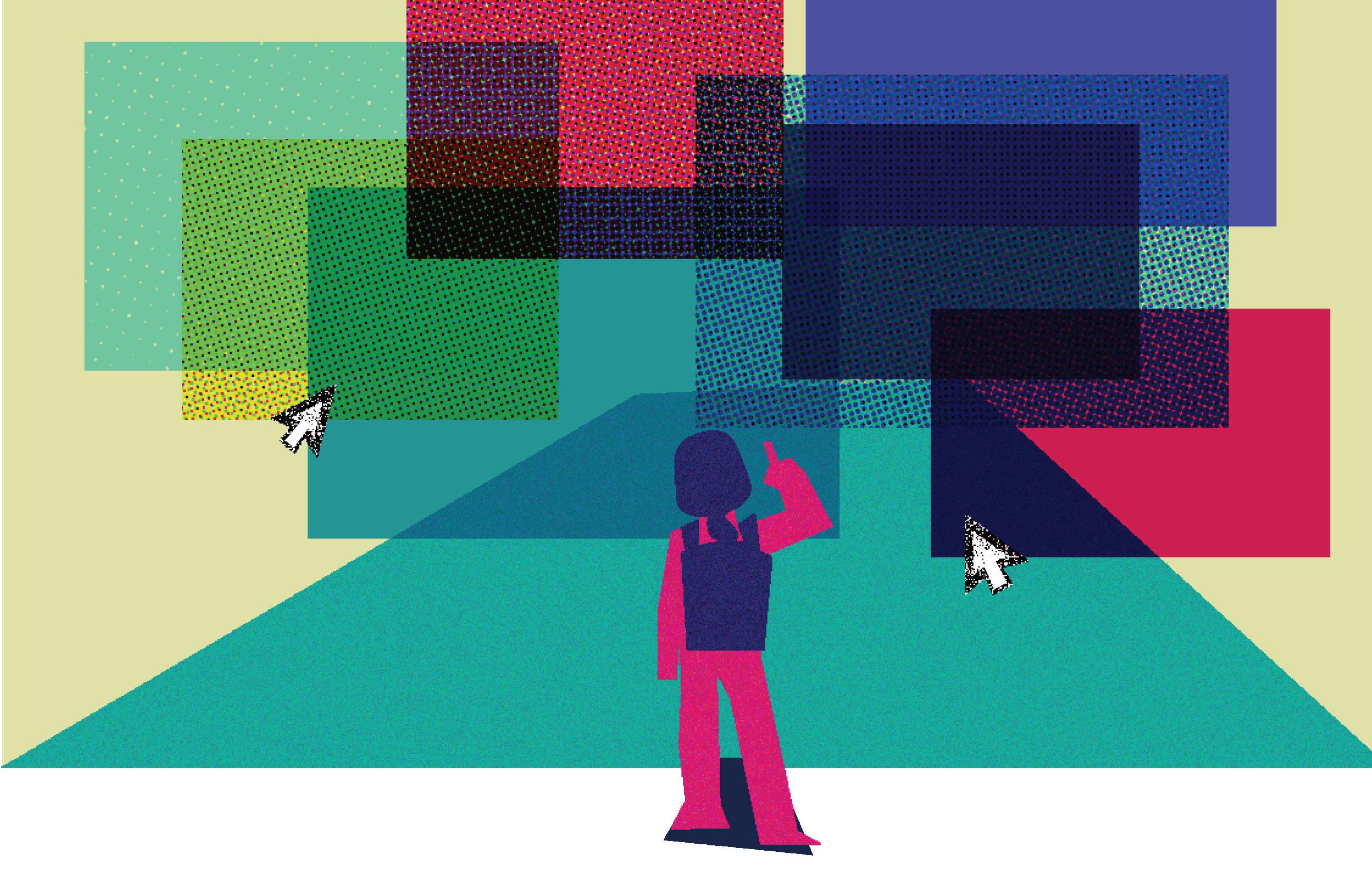
over once they get to campus. But to Keatyn Wede (CAS ’27), it never seemed that funny.
When Wede came to visit as a prospective student during Georgetown Admissions Ambassador Program Weekend, a university speaker joked about the inconvenience of Georgetown’s application website.
“I remember everyone in the room was laughing, but I was like, ‘It’s really not that funny.’ It was so awful; you guys are giggling, but I didn't know what was going on,” Wede said.
Wede is from a small town in South Dakota. In her graduating class of about 180 students, only three left the state for college, she said. Coming from a high school that didn’t have the resources or staff to support students applying to selective universities, Wede felt underprepared for her college research and application process. Georgetown’s application platform only made this worse.
Nationally, rural students are less likely than their urban and suburban peers to go to college at all. Some of these students said that Georgetown’s separate application platform— along with other aspects of Georgetown’s application process like recommendation letters and a lack of university outreach—makes admissions even more inaccessible.
“I feel like it’s so pretentious to not be on the Common App,” Wede said. “On the record, Georgetown admissions: I think you're pretentious.”
The Common App is a shared application platform used by over 1,000 colleges and universities. It offers one platform to upload essays,
counselors, input demographic information, and list extracurriculars or work experience.
Of U.S. News and World Report’s top 50 universities, Georgetown and MIT are the only private universities not on the Common App. Instead, they require students to provide all their information in an entirely separate, universityspecific application.
Having a separate platform complicates the application process for both students and school counselors. Rural high schools are often underfunded and understaffed, leaving counselors with a high caseload of students and without the support, capacity, or training to provide individualized help with college applications. Many of these counselors are not very familiar with the process for students applying to college, especially to out-of-state or selective private universities.
“My guidance counselor had no experience even with the Common App, so when I first sent her that, she was confused. But then I sent her the Georgetown one, and she was more confused,” Wede said.
Students also criticized the fact that applicants have to pay Georgetown’s application fee when they first open an account, before they’ve filled out or submitted their full application. The fee is $75, unless a student qualifies for a waiver. Georgetown’s admissions website encourages applicants to open an account “as soon as possible.”
“Having to pay beforehand too, before I even knew if this is a place I fully wanted to apply to
Wede said that figuring out Georgetown’s separate application, including the fee to open an application, was confusing, especially when compared to the Common App, which doesn’t require a fee to open an account.
“In all of the education I did trying to figure out how to apply to colleges, the Common App made that so much easier, because it was universalized,” Wede said. “Once I figured out this one platform, I could figure it out for so many different schools.”
Despite student complaints, university officials have maintained that Georgetown’s separate application is an asset because it makes the application process more personal and encourages students to research the school more closely before applying.
“Georgetown believes an individual application better reflects the personal experience of transitioning into college,” a university spokesperson wrote in an email to the Voice. “We also believe the distinct application process ensures stronger interest in Georgetown from students who apply.”
Lisa Kennedy (CAS ’25) said that having a separate application platform did help her learn more about the university, especially as a firstgeneration student coming from a small town in Wisconsin. Kennedy’s hometown has a population of about 7,000, and she said most students from her high school don’t continue to college.
Kennedy is now the president of Georgetown’s Association of Small Town and Rural Students (STARS), which she founded in fall 2022, hoping to address insufficient
8 THE GEORGETOWN VOICE
design by olivia li
FEATURES
outreach to small-town and rural students and help them build community at Georgetown. She’s also co-president of the student board for the Georgetown Scholars Program, which works to support first-generation and low-income students at Georgetown.
“I felt that Georgetown’s separate application platform definitely made it so that I learned more about Georgetown compared to other schools,” Kennedy said. “I honestly think that may have been better for my experience, just because it forced me to learn about the college and actually feel like I had some stake in the matter.”
However, other students from small towns and rural areas felt that rather than encouraging research, the separate platform prevents students in these communities from learning about Georgetown or considering it as an option.
“I feel like switching to Common App would be way easier,” Lewis said. “If they're trying to reach more students who might not even know the school exists, having it on that list would be very helpful.”
A study by the National Bureau of Economic Research found that after joining the Common App, colleges saw an average increase of 12% in the number of applications received the following year. This rose to 25% after a decade of being on the Common App.
Wede agreed that the separate application makes it harder for students without a familial or academic connection to Georgetown to learn about the university.
“The research then becomes easier for legacy students. It becomes easier for kids who have college counselors. You’re just setting up another barrier for kids who don't have access to research resources,” Wede said.
This may help explain why Georgetown students admitted from small towns and rural areas are more likely to be legacy students.
In summer 2022, Kennedy conducted research with Georgetown’s Office of Undergraduate Admissions, where she compared applications from rural and nonrural admitted students. She found that 20% of her rural students sample had legacy status, compared to about 3% of her non-rural student sample. Across the university, 4% of applicants and 9% of students have legacy status.
Kennedy said that legacy students, including those from small towns and rural areas, have a built-in connection to Georgetown that encourages them to apply.
“Rural students are more likely to come from a first-generation low-income background—they require more outreach and more touch points, just to convey to them that this is an option,” Kennedy said.
Kennedy’s research also revealed major disparities between recommendation letters submitted by rural and non-rural students. Georgetown, along with many elite universities, requires applicants to submit a letter of recommendation from a school counselor, which can be challenging for students from rural areas
whose schools often do not have the staff to provide that support.
Kennedy found that the counselor letters of recommendation for non-rural applicants were, on average, almost twice as long as those for rural applicants—at a mean length of 684 and 358 words, respectively.
“When it came to letters of recommendation, I felt like I was really at a disadvantage because my teachers, and especially my counselors, had never really experienced the application process for a student who was applying to a school like Georgetown,” Kennedy said.
Rural youth are also more likely than their peers from urban and suburban areas to go to public schools, which are often underfunded and understaffed. In Kennedy’s research, 93% of her rural applicant sample and only 23% of non-rural applicants came from public secondary schools.
Guidance counselors at underfunded public schools, both in rural and non-rural areas, primarily work to manage disciplinary processes or provide emotional and social support for students in crisis, leaving little time to help students with competitive college applications.
“I had actually never interacted with my guidance counselor, and so, when I was asked to obtain a letter of recommendation from my college counselor or guidance counselor, that didn't really make much sense,” Kennedy said. “That counselor letter of recommendation requirement was just a huge barrier for me.”
Kennedy worried that the requirement deters some students from applying altogether.
“These are the students that we've gotten to apply and who chose to apply despite these barriers, but I can't imagine how many students we might lose to those barriers, who see that and say, ‘Oh, I guess I can’t apply here,’” Kennedy said.
Kennedy and some other small-town and rural students said that making the counselor recommendation letter optional would encourage more applicants like them to apply.
Aside from addressing challenges with the application requirements, students told the Voice that greater outreach from the admissions team would help support small-town and rural students applying to Georgetown.
“I get that they're not feasibly probably going to get to every small town, but I guess you can always send an email to [a] school,” Lauren Bartels (CAS ’26), programming chair for STARS, said.
STARS’s outreach efforts have touched a number of current Georgetown students. In spring 2023, Kennedy held a Zoom conversation for admitted students from small towns and rural areas, which Wede attended.
“Lisa was one of the reasons I committed, because I was like, ‘Oh my god, everything she’s saying is something I would say, and if she can do it, I can do it,’” Wede said.
The lack of official university outreach is more than just a Georgetown problem. Universities in general are less likely to hold college fairs or organize admissions officer visits in these communities, instead favoring suburban and urban schools where a recruiter can reach a greater number of students in one trip.
The only college recruiters who came to Bartels’s school in her Wisconsin town of 2,500 were from the state’s public university system or nearby community colleges, Bartels said.
“I can tell you with complete certainty that there were never recruiters coming from elite universities. Most people didn't know what Georgetown was when I told them where I was going to school,” Bartels wrote in an email to the Voice.
Without active outreach from universities, small-town and rural students and their high school staff may not consider selective, out-ofstate schools as an option.
“The primary route was trade school or going directly into the workforce,” Kennedy said about her high school. “I just feel that trade school or community college was more highly encouraged by my teachers and administrators.”
Recently, Georgetown has created additional outreach programs, in part to support applicants from towns like Kennedy’s.
“Georgetown founded a joint travel consortium in 2022 with four other universities that share a commitment to reaching talented students in small towns and rural communities,” the university spokesperson wrote in an email to the Voice . “This consortium consists of Brown, Georgetown, Harvard, Howard, and USMA West Point, traveling together biannually with a focus on underrepresented regions.”
Aside from the travel consortium, Georgetown’s outreach also involves high school visits as well as both in-person and virtual campus tours, information sessions, application and financial aid workshops, and connecting current and prospective students from similar backgrounds, the university spokesperson wrote.
“Georgetown is committed to multicultural recruitment and supports prospective students from all backgrounds and geographic regions throughout the recruitment and application process,” they wrote.
However, some feel that these efforts haven’t done enough to reach small-town and rural students, who still may never have heard of Georgetown.
Students emphasized that further supporting these applicants can have a big impact on their communities and their futures.
“A lot of rural and small-town students don’t go to college or don’t get this level of education,” Wede said. “The impact of having students coming from those areas who are receiving an education like this is that they can go back, make an impact on their community, how their community functions, and the way that our country as a whole functions.”
9 APRIL 26, 2024



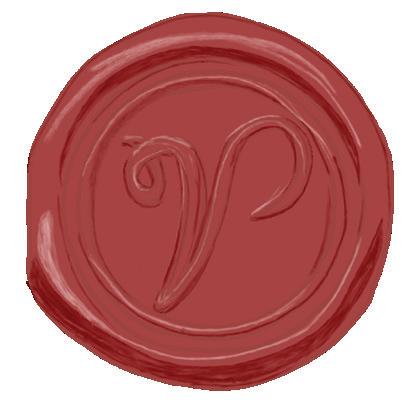

give up, and if one door closes, another will always open. My dad taught me the beauty of accepting who you are and how you come to be. My parents’ resilience and dedication gave me and my sisters, Ashley and Araceli, all the options and opportunities they were never given.
My mom grew up in Mexico, where she received a university education in pedagogy. Shortly after, she left her job as a teacher and moved to the United States. My mom was 20 years old when she had me, which meant we would grow up together. Despite migrating to the United States with one blanket and $200, she created the life she wanted. It takes strength to leave behind everything you know in hopes of creating something bigger. These past four years of university would not have been possible without the power of my mother’s warmth, encouragement, and rooted belief in me. Speaking to other Georgetown students with immigrant parents, we share the same sentiment that our mothers continue to help us grow—even from a distance.
My dad grew up in a poor family in a small town in Mexico, where he only attended school until the seventh grade. When I was little, I was scared to fall asleep in the dark. My dad would lie beside me and tell me his
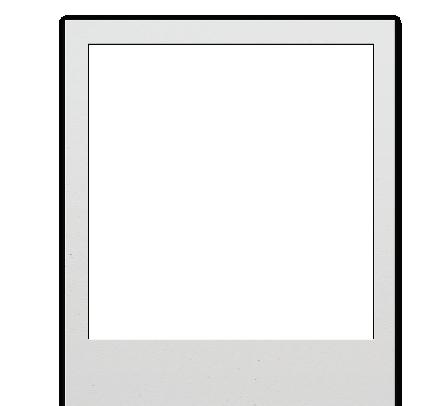
moments, I saw my dad as a child. He dreamed of becoming an architect. Unfortunately, my grandfather clipped my dad’s wings. He believed that education did not matter, and, even so, obtaining a university degree seemed economically impossible. Instead, my dad left his home country at around 16 years old, in search of a higher-paying job. At that same age, I was preparing myself for the college application process. It never crossed my mind that I could handle leaving behind my home as a child. I often find myself glancing over at the construction workers across campus and D.C., greeting them—they remind me of my dad, of what I left behind. I can’t help but wonder about their stories. I see the faint smiles on their faces, their humanity beyond their labor. Through each of them, I water my dreams and hopes for my future.
The vast difference between the life my parents gave me and the life they had leaves an ache that I will carry with me endlessly. I had to navigate college as a first-generation student courageously, because how do you tell your immigrant parents you are suffocating? I’d tell myself that the weight of figuring it all out had to be lighter than that of leaving your homeland. There were days when my heart felt heavy and I felt myself falling—but I know that we firstgeneration college students simply don’t get that privilege. Your strength, Mom and Dad, pushed me through every semester of college, through every milestone; even from 2,500 miles away, I felt you near.
My family and I all knew that to build the life we wished for we would need to protect and uplift one another. My parents planted
They ensured that no matter what challenges faced us, we believed we could get up and try again. Limitations and excuses did not exist in my household. They found strength within the constraints attached to impoverished people and immigrants.
My parents never denied the difficulty that came with their circumstances. Their hard work paid off, and though we are not a wealthy family, we have come a long way from the one-bedroom apartment we slept in. Through every lesson and struggle, my parents’ strength was unwavering. Even when there was no sunlight around me, I could count on them to guide me along the way. My mom, who always has a solution for everything. My dad, who somehow always checks in on my hardest days and reminds me why I am here. They’ve dedicated themselves to ensuring that I can accomplish my dreams. Immigrant parents around the country, and among our Georgetown community, continue to share their power and magnitude while standing aside to watch us flourish and step proudly into their shoes. Even so, many immigrant families and students are left behind, failed by an increasingly brutal legal system and a lack of access to educational spaces. This is for them too.
I could write books expressing the love and respect I hold for my family. Every single one of my successes is for my sisters and best friends, Ashley and Araceli, and our parents, who gave us everything and more. To my family, I thank all of you for holding me up every step of the way and encouraging me to reach for the stars. With this, I give the greatest congratulations to the Class of 2024 and commemorate those who came from unconventional backgrounds and pathways.
10 THE GEORGETOWN VOICE photos courtesy of esmeralda vazquez; design by madeline jones
10
A gentlewoman’s guide to going out alone
BY SHANA STRUSKI
In the spirit of transparency, I’m going to be vulnerable with you all.
For the first few weekends of my freshman fall, I barely left my room. Sure, there was the occasional rooftop party and my inaugural visit to Dupont Circle, but I still felt an inexplicable ache whenever I was alone. On these solitary weekends, I spiraled, imagining myself to be the epitome of loneliness. I occupied myself by calling my entire family; even my grandma was subjected to hearing about my pitiful lack of exploits. At one point, my dad remarked, “You seem sadder on weekends.”
Whatever, so my high school dreams of becoming a fully actualized “cool girl” were nowhere near being fulfilled. My weekends did not mirror the college stereotype of barhopping and staying out until 3 a.m. Rather than lament over what could have been, with mere weeks remaining in my freshman year, this is instead a guide for my much more naive freshman fall self, who dreaded even the slightest leap out of her comfort zone.
During these depressing days of yore, I constantly bemoaned having friends who “didn’t like to go out,” placing the blame anywhere but on myself. My spunky aunt from California told me to go to parties by myself. What? Was she crazy? This advice went against everything I had ever heard.
Coming from a small town, I was constantly warned to not go into the city by myself. Thanks to the infamous “Georgetown Bubble,” this wasn’t too much of an issue. The real obstacle is that everyone is busy with conflicting schedules. It’s not easy coordinating an Uber for a quick trip out, and when you manage to achieve that, it’s no fun wrangling your friends to pay you back.
(I should add my disclaimer that women need to be especially careful, and yes, we probably shouldn’t go out alone at night. I could get into my many thoughts on how much more difficult it is for women to exist in the world compa red to men, but I’ll save that for another day. For now, though, let’s pretend the principle of ceteris paribus holds here).
On the lazy days when I had managed to escape the wrath of Lauinger Library, I
realized I could either rot in my bed or get a taste of the outside world. Even if it meant I had to do it alone.
On one such gloomy September morning, I received an email offering free tickets to an indie movie screening. I was elated: this was precisely the kind of sidequest I wanted to embark on. The problem was that no one in my immediate circle had any interest in seeing the movie. That evening, I went against the grain; I skulked through the darkness to the local AMC. When I arrived, I pinpointed a girl who seemed to be in the same position as me: standing alone, shifting rather awkwardly. Mustering up my courage, I struck up a conversation with her and found that she, too, was a Georgetown freshman whose friends didn’t share her enthusiasm for arthouse films. I now refer to this very girl as my movie friend, and we have been going to movies together ever since. This exercise in solo spontaneity engendered a sense of community, resulting in a new friend made by virtue of being alone.
A few weeks later, I came across a newspaper flier advertising the World Culture Festival taking place at the National Mall later that afternoon. With such short notice, I once again ventured out alone. I soon enough found myself seated eagerly on the GUTS bus, then clutching a handrail on the Metro. Upon exiting the Metro, I was immediately swept up by a chattering crowd of tourists flocking to the same destination as me, my feet hardly touching the ground. I wandered through hordes of marching bands and was entranced by an array of vibrant hues. Entering the city alone thrust me out of the mundane. I walked along the paths of people who weren’t part of the Georgetown student hive mind. Here, surrounded by individuals from all corners of the earth, I felt that I wasn’t truly alone, and even if I was, there was still room for me to belong as my authentic self.
I recall how uneasy I once felt about activities as painless as attending club meetings by myself. I had a sense that it would, at best, lead to awkward exchanges of Georgetown intros, and at worst,
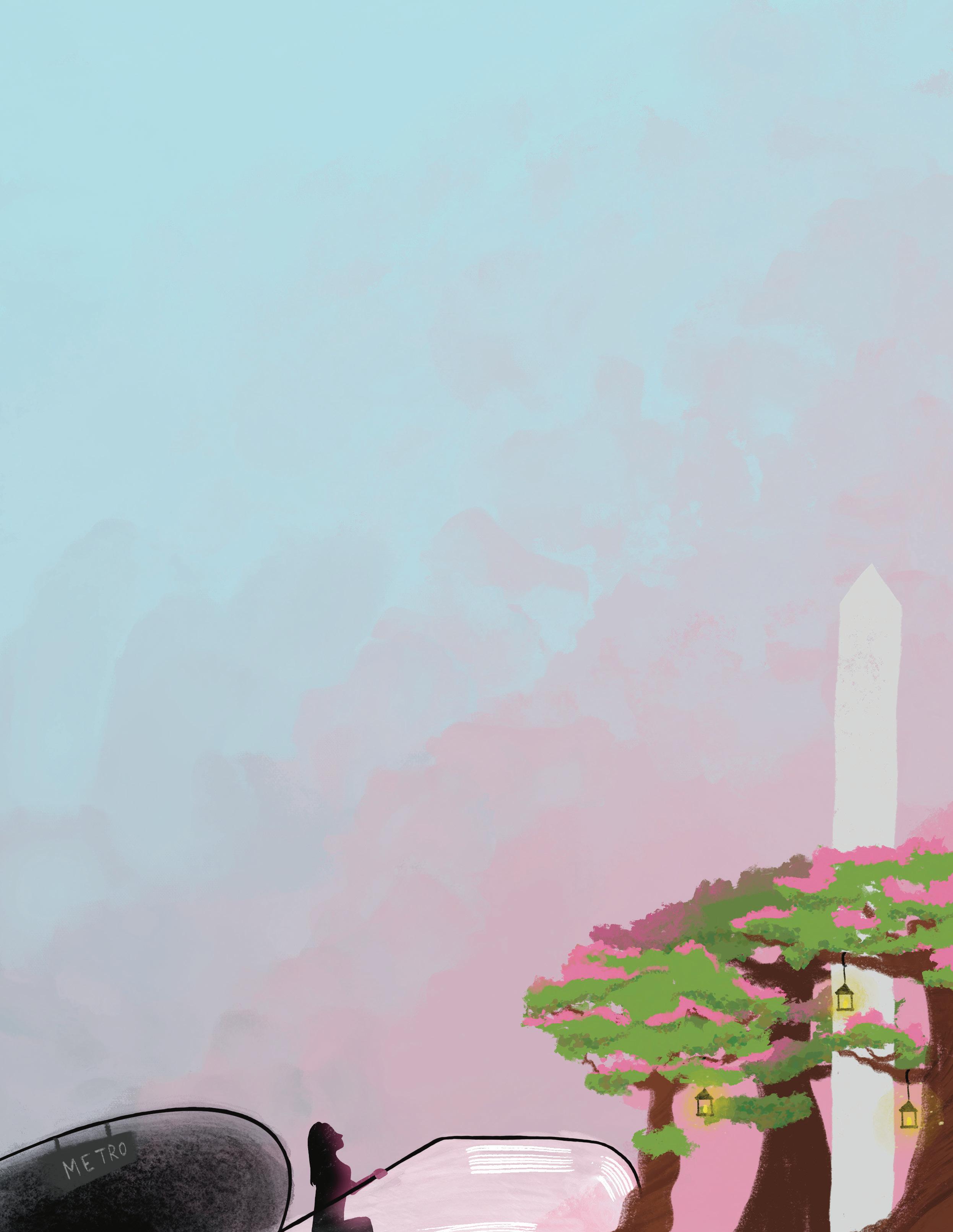
lead to social ostracism of the highest order. But despite the hyperconceptualization that occurs in our heads, taking this simple risk alone often pays off. I first joined the Voice when I tentatively approached the office in Leavey and observed what may have been the tensest editorial board meeting in organization history. But now, I consider the Voice to be home to some of my dearest friends and one of my favorite places on campus. College, and young adulthood in general, is about going outside of your comfort zone. I have had so many adventures freshman year— from neighborhood library trips to Kennedy Center concerts—that would have never been possible if I had avoided flying solo. Through these outings alone, I have grown to be confident in my ability to be my own person and have built lasting friendships. I find that, as children, we have a tendency to lament total dependence, only to shirk our newfound autonomy as adults. We need to be secure enough in ourselves to exist outside of our relationships with others. The freedom of being alone can teach you about what makes you happy and almost paradoxically lead you to a more expansive community of people who bring you joy. For the sake of both your individuality and your social life, go forth alone. There’s a lot outside of the bubble worth venturing out for.
VOICES 11 APRIL 26, 2024
design by lou jacquin
3 Body Problem creates harmony from science ction chaos
BY ZACH WARREN
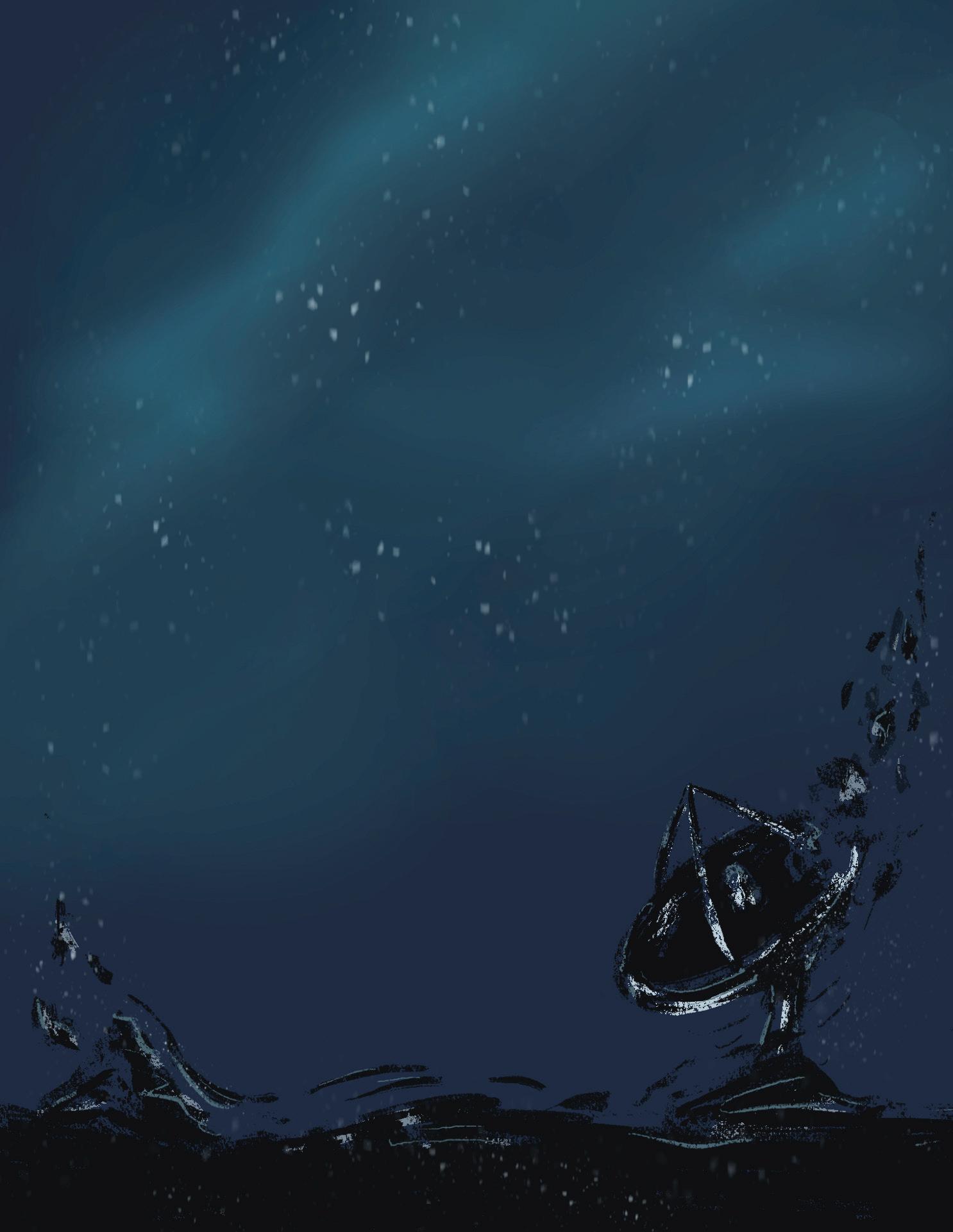
Spoiler warning for 3 Body Problem (2024).
Amember of the Red Guard lethally strikes a professor with a belt as the Cultural Revolution rages through 1960s China. An Oxford researcher laments the shutdown of the university’s particle accelerator after it seemingly defied established laws of physics. A detective in London examines the unusual death of a scientist who had scrawled a countdown in his blood over the walls. Despite having seemingly no similarities between them, these three scenes open Netflix’s latest smash-hit, 3 Body Problem (2024), and they make for a phenomenal introduction to a series that has enchanted millions.
Based on Liu Cixin’s novel, 3 Body Problem tells the complex story of a group of scientists looking to solve a series of mysteries afflicting the global scientific community. Rather than opt for a typical episodic structure, the show boldly chooses to weave multiple narratives together, allowing them to unfold and interact simultaneously. Most shows would buckle under the pressure of adequately telling a story split into so many parts. Yet, 3 Body Problem almost perfectly juggles its various plotlines, resulting in a binge-worthy eight-episode drama that innovates on classic science fiction themes.
Perhaps what will draw most viewers in is the mosaic of conundrums that suggest the entire study of science is falling apart. The series incorporates myriad subjects on the cutting edge of science, ranging from particle physics to virtual reality; the show evokes predecessors like Black Mirror (2011-present) in exploring technology’s potential to harm rather than do good, posing questions equal parts philosophical and polemical. For the first few episodes, these puzzles simmer in the viewer’s mind, allowing them to spin elaborate theories as they watch.
Easily the most perplexing problem is the literal and figurative death spiral the global scientific community is experiencing at the series’s start. On top of the apparent degradation of the laws of nature, scientists themselves are inexplicably dropping like flies. In fact, the troubling death of researcher Vera Ye (Vedette Lim) is what brings together the show’s central crew, her former assistants at Oxford.
We find that, though brought together by this tragedy, all are encountering their own enigmas. Saul Durand (Jovan Adepo) lost his job after his particle accelerator inexplicably began producing nonsensical data. Augustina “Auggie” Salazar (Eiza González) begins seeing an ominous countdown visible only to her, threatening her to halt her
nanofiber research lest it reach zero. Lastly, Jin Cheng (Jess Hong) discovers a futuristic gaming headset capable of creating immersive virtual reality simulations far beyond current technological capabilities. Though these oddities seem completely unrelated at the onset, there is an ever-present inkling that they are merely symptoms of a bigger picture. That nagging feeling keeps viewers enthralled as they attempt to unravel the thriller.
By the fourth episode, the pieces start to fall into place—and the answer lies beyond the stars. Causing this chaos is an intelligent alien species known as the San-Ti who have amassed a cult on Earth to help them travel to and rule over humanity as their benevolent overlords. Using advanced alien technology, the cult has been sabotaging the Earth’s scientific community in order to remain hidden and prevent humans from developing any defense against the outer-world invaders.
Admittedly, the alien explanation may not seem that creative, but 3 Body Problem carves out its own niche by avoiding the “little green men” cliches that plague most extraterrestrial invasion media. For one, we never see what the San-Ti look like; they communicate with humans only through AI projections. Their method of warfare is also mental rather than physical—instead of arbitrarily destroying monuments like in Independence Day (1996), the San-Ti attack humanity’s knowledge and capability to resist, influencing humans to halt their own scientific progress. In the current season, the audience is not watching the actual invasion but the prologue—a looming apocalypse, rather than an actively unfolding one.
By the fifth episode, the show transitions from sci-fi mystery to sci-fi disaster as the San-Ti demonstrate their awesome power by projecting the phrase “YOU ARE BUGS” across every screen on Earth simultaneously. With hope for peace dashed, the protagonists attempt to produce a plan to fend off the invasion amid international crisis. Though some momentum is lost with the transition, the new storyline elevates the sense of tension and dread that had only been teased earlier. The serene terror of the San-Ti and their perceived omnipotence makes for a truly menacing antagonist and villain for seasons to (hopefully) come.
Thematically, 3 Body Problem flirts with concepts of technological advancement and the ethics of scientific progress. In the show, the British government exploits cutting-edge technology, global resources, and innocent lives to advance its mission to discover and defeat its alien enemy. Loss of life is dismissed in the name of the “greater good,” posing troubling questions
about whether the ends justify the means. It’s no coincidence the first scene of the season retells how China’s Cultural Revolution justified the brutalization and deaths of Chinese scholars for similar reasons. Quite poetically, this event sets the main plot in motion, as Ye Wenjie (Rosalind Chao/Zine Tseng), daughter of a slain Chinese professor, becomes the first person to contact the San-Ti in the 1960s. Ye’s loss fosters her cynicism over humanity’s ability to govern itself and the Earth, leading to her fateful decision to contact the San-Ti in a cry for help. Both then and now, humanity’s present desire for advancement has doomed future generations to an existential threat—a not-so-subtle metaphor for the numerous challenges our world faces today.
From a narrative, stylistic, and thematic perspective, 3 Body Problem takes on a lot. Scenes shift dramatically between characters, settings, and genres, demanding your undivided attention to follow along. Yet, those who choose to fully engross themselves will quickly find themselves obsessed with the masterfully told story and nuanced discussion of scientific progress in the modern world. The ambiguous ending of Season 1 opens the door for future seasons to go in multiple different directions, and with positive reception from fans and critics alike, 3 Body Problem will hopefully be making a rapid return to our screens.
12 THE GEORGETOWN VOICE HALFTIME LEISURE design by rachel zhangsign
Dancing the night away to banda
and corridos, Ballet
Folklórico Mexicano de Georgetown brings brilliance to the student dance community
BY SOFIA KEMENY
“Five, six, seven, eight!”
This call to order invigorates the otherwise quiet and corporate interior of the Healey Family Student Center (HFSC). Heels clack against the hardwood in sync. Lively gritos echo throughout the building. Vibrant ruffled skirts fan out with every spin, imposing themselves on the greige walls of the HFSC dance studio and hypnotizing all who pass by. With an undeniable commitment to its art, Ballet Folklórico Mexicano de Georgetown (BFMG) is more than ready to command your attention at its annual spring showcase in Gaston Hall on April 28.
BFMG is a student-run dance ensemble dedicated to sharing traditional Mexican folk dance. Every year they present a comprehensive cultural showcase, highlighting niche sects of folklórico from all over Mexico. This year’s show, titled “Plaza Hoya: Noche de los Animales,” plays with performance; the majority of their numbers are choreographed in the image of a certain animal.
“You’ll see dancers acting like the animals that the song is named after,” Amy Cazares (CAS ’24), the group’s co-director, said. “We wanted to really tap into the dances and costumes that we haven’t used at all. So, that’s what we’ll be doing!”
Perhaps the dance most indicative of this theme is “El Toro Mambo.” Originating from Sinaloa, Mexico, “El Toro Mambo” depicts a playful spat between bulls and humans. Introduced by the blaring of trumpets, dancers playfully twirl their skirts to entice the “bulls,” creating a kaleidoscope of brilliant yellow, orange, and pink. The skirts’ delicate motions juxtapose the bulls’ aggression; they charge onto the stage stomping and clattering their feet, but the sound of their footwork only compliments the accompanying music. Full of movement, sound, and color, there is never a dull moment in “El Toro Mambo.”
More often than not, Mexican folk dance is known for its difficult-to-execute and often contradictory movements. While the footwork is sharp, with each step striking the ground, the arm motions must be smooth and flowing as the dancers channel the air around

them to billow their skirts. The contrast between these two simultaneous moves is entrancing yet onerous. Despite the technical difficulty, BFMG is almost entirely comprised of beginner dancers and a leadership team committed to compassionate teaching.
“Even if you don’t know how to dance, even if you have two left feet, we want you here,” Adriel Perez (CAS ’25), one of BFMG’s choreographers, said. “When I teach, I try to adjust to everyone. I try to focus on everyone’s skill level and make it understandable for everyone. Dancing is only fun when you’re having fun.”
Upon viewing rehearsals, it becomes abundantly clear that BFMG is not just a group of student dancers; it is more reminiscent of a found family, full of people who have found community with like-minded peers. Georgetown’s student body is predominately white and wealthy, making it easy for minority populations to be overshadowed and underrepresented. Brought together by similar backgrounds and cultural affinity, BFMG acts as a guiding light, encouraging students to come out of the shadows and find comfort in one another.
“A big part of our group is that we come from very, very similar backgrounds. Maybe we’re all in GSP [Georgetown Scholars Program] or maybe we’re all first-gen, low-income students. It’s really nice to talk to people who get it. With peace and love, a lot of people at this school do not understand what it’s like to come from a background which we are from,” Cazares said.
More than just a dance group committed to its artistry, BFMG has become a home away from home for its members. BFMG has become an enclave of latinidad, where the Spanish language reigns supreme and students partake in the cultural customs they may have left at home; the group empowers students to come into their own.
“[In BFMG], I can find a space and express art like this that you don’t see a lot. It’s such a unique form of dancing,” Juliana Melara-Recinos (CAS ’27), a new member of BFMG, said. “What I’ll take from [this experience], is that I can find a voice and I can find spaces like this where I feel like I belong.”
This sense of belonging and trust between members breathes life into their work. In their dance representing Hidalgo, Mexico, the dancers are inches away from one another, closely weaving their bodies around their partners. Rather than looking at their feet, the dancers hold intense eye contact, gazing at each other with an undeniable sense of care and gratitude. As the guitar sings in the background, guiding their movements, it becomes nearly impossible to watch the dancers interact without a smile creeping across your face.
Though Hidalgo only features four dancers––Cazares, Perez, Xavi Molina (CAS ’25), and Nini Skevofilax (SFS ’26)––non-participating members in rehearsal could be seen watching intently, eyes glimmering with awe, if not attempting to recreate the moves themselves. At the end of every number, raucous applause swiftly followed.
BFMG oozes with creativity and sheer talent, but only talking about their skill would eclipse the aspect they value most: community building. An unmistakable warmth envelopes every space BFMG chooses to make its own. When reviewing steps together, subsequent success is rewarded with joyful cheers and hugs abound, as dancers insist on helping one another however they can. Through familia nights filled with food, music, and more dancing, BFMG strengthens its performances by building a firm foundation of shared trust and compassion.
Intense competition and elitism often shroud the dance world, lacing the space with negativity. However, as BFMG serves up intricate performances with a side of love, they break away from the status quo. Put most eloquently by Cazares: “Where else on campus could you find this?”

Plaza Hoya: Noche de los Animales will take place April 28 at 8 p.m. in Gaston Hall and will include guest performances from Ritmo y Sabor, GUVSA, GW Folklorico, and Victoria Saeki-Serna. Tickets are free and can be reserved on Eventbrite.
13 APRIL 26, 2024 design by maggie zhang LEISURE
The state of sports
BY BRADSHAW CATE, ANDREW SWANK, JO STEPHENS, AND ANNA CORDOVA
In 2023, the sports betting industry in the United States surpassed $10.9 billion dollars in revenue, representing a smashing 44.5% increase from the previous year. As such, Voice Sports has decided to recap the good, the bad, and the ugly of the industry.
Sportsbooks' journalism takeover
I get most of my sports recaps from podcasts like the Dan Le Batard Show and, over the past few years, I’ve noticed a marked shift in their advertisers. What was once O'Reilly Auto Parts has now become DraftKings. What’s more, go into any bar playing ESPN and see that what used to be a ticker with score updates now shows betting odds and an over/under line.

Gambling ads are helpful for supporting independent podcasts; however, for ESPN—the self-proclaimed “worldwide leader in sports”— this coupling of betting lines and news updates, which can directly change those lines, seems ripe for exploitation.
For this reason, I was horrified when I opened my ESPN app and saw “ESPN Bet” all over my screen. In November 2023, ESPN partnered with PENN Entertainment to create an online sportsbook with the global brand’s name. Not only did the largest sports media conglomerate launch a sportsbook, they did so by subtly rebranding their SportsNation social media accounts, which already amassed over 10 million followers, forcing users to engage with ESPN BET.
One example of the ethical dangers of this deal occurs when journalists release gambling content. For the 2024 NBA Playoffs, ESPN News released an article analyzing the bets to make during the NBA playoffs. While the writer has clearly put expert thought into his picks, his advice is cheapened when coupled with a large ESPN BET button in the website’s navigation bar. To be clear, the journalist did nothing wrong by releasing this article, but the potential for this advice to sway the betting lines on ESPN’s own sportsbooks raises significant ethical questions. An ESPN analyst has already had to issue an apology for claiming live on-air that a colleague’s March Madness over/ under picks through ESPN BET were “a risk-free investment.”

ESPN BET has also created an even worse scenario for exploitation. Under ESPN’s own guidelines, employees are not allowed to place bets on any sportsbook after obtaining confidential information. However, what if the reporter informs a friend and no one catches them? What if that journalist is not caught betting? What if a reporter accidentally misled the public when releasing news, causing betting lines to change—something that many accused The Athletic’s Shams Charania of doing during the last NBA Draft? The number of what-ifs this move has created should be enough to shut down the sportsbook. Yet, the money is lucrative, and after years of ESPN laying off top talent like Dan Le Batard, Jeff Van Gundy, and Jalen Rose, the sportsbook is quite clearly an important asset in ensuring the future success of the company. But for the sake of sports journalism writ large, maybe it shouldn’t be.
-Bradshaw Cate
Lessons from across the pond: Betting and soccer in England
Over in the United Kingdom, a long-standing system of sports betting provides a model for a (somewhat) healthy, lasting relationship between betting and sports. Betting shops became legal in the 1960s, and since then, betting has become a huge part of the British sports economy. In particular, the Internet Age has made it easier to bet through gambling websites, with the most popular garnering tens of millions of monthly users. The total market size for sports betting in the UK was estimated at $5.4 billion in 2021.
Out of the millions of users, many have a healthy relationship with betting. However, there may be millions of adults across the UK who are struggling with a gambling problem, according to the Gambling Commission, with some estimates reporting that over 60% of gamblers have issues with debt.
Currently, eight of the 20 teams in the Premier League have a betting company as their primary shirt sponsor. That means that for fans of 40% of England’s elite clubs, every time they watch a game, buy a jersey, or see photos of their favorite players, they’re looking at a gambling ad. Although the league is getting rid of gambling sponsorships on the front of teams’ kits by the start of the 202627 season, ads will still be allowed on the sleeves and throughout teams’ stadiums.
The Premier League’s close relationship with the betting industry is not something that just impacts fans. Similar to U.S. pro leagues, players in all of England’s professional soccer leagues are not allowed to bet on soccer, although they may bet on other sports. However, many players have run afoul of this rule in recent years.
Ivan Toney, a striker for Brentford F.C., received an eight-month ban for betting on his own club, including bets on his own team to lose some games he did not play in. Newcastle United F.C. midfielder Sandro Tonali, who joined the Premier League club for a huge $70 million fee, received a 10-month suspension for betting on matches in Italy.
The frequency of these suspensions might be a sign of a new normal for professional sports. The lifetime ban of Jontay Porter from the NBA sent shockwaves through American sports, but players in England who committed similar offenses received much more lenient punishments. American sports leagues must respond to the rise in sports betting, and the example of European soccer shows that when gambling and sports have a close relationship, players can and will run afoul of gambling rules.
When players struggle with gambling, leagues should offer support and resources. In an interview after the conclusion of his suspension, Toney described his relationship with gambling as “unhealthy” and said he was “naive” when he was betting. Athletes like Toney who show self-awareness and growth don’t deserve lifetime bans. Creating established but lenient guidelines for players who break gambling rules is crucial for American sports to build a strong relationship with the betting industry.
-Andrew Swank

10 THE GEORGETOWN VOICE graphic by paul kang; layout by elin choe
HALFTIME SPORTS
sports betting

Betting on the growth of women's sports
On the surface, sports gambling seems like a male-coded hobby. Most of the big bets are men’s sports, and almost 70% of all sports bettors are male. One of the less examined benefits of sports betting, though, is how it can be utilized as a tool for growing women’s sports.
Take women’s basketball, for example. Sportsbooks reported a significant increase in betting interest on this year’s women’s March Madness. With games being played on more accessible TV networks, and with superstars like Caitlin Clark and Angel Reese becoming household names, the market has exploded—and thus betting has too.
This, in turn, gives people who might not otherwise watch women’s basketball consistently a reason to tune in more often. And once they’re there, well, some of them will genuinely enjoy watching the games, building up a larger fanbase who will support the teams they once watched only for betting purposes.
This mentality doesn’t stop at the collegiate level, either. With the aforementioned Clark’s recent entry into the WNBA, sportsbooks have exploded with related bets. Per FanDuel Sportsbook’s social media, the Indiana Fever (Clark’s new team) have received the most bets to win the WNBA championship this season, and Clark herself has received 10 times more MVP bets than any other player in the league.
Now, whether these bets are intelligent ones or not is a different conversation. The fact remains, though, that women’s sports are on the come-up, and sports betting can aid them in that climb.
There are, of course, pitfalls to this line of thinking. For starters, there’s no guarantee that people who bet on these games will stick around— though statistically speaking, some of them likely will. Additionally, some of the ideas that sportsbooks promote about the women’s game are simplified to the point of being disingenuous.
They focus on the stars, the media darlings. Those looking at sportsbooks for the WNBA will see a lot of things about Caitlin Clark and not a ton else, at least right now. This hyperfocus on certain individuals might help create interest and grow the game’s watchers, but it isn’t sustainable long-term.
But those problems don’t outweigh the benefits—because women’s hoops are on the rise. For the first time ever, women’s March Madness final had more viewers than the men’s tournament (18.87 million to 14.82 million). Caitlin Clark just signed an eight-figure deal with Nike that’ll come with a line of signature shoes. Her Fever will have 36 of their 40 games televised nationally (the Las Vegas Aces will have 35 and the New York Liberty will have 31). Women’s basketball is here, and sports betting can help it reach even greater heights.
-Jo Stephens

The NBA's growing pains in the age of sports betting
Last month, during crunch time of a close game against the Cleveland Cavaliers, Rudy Gobert, the center for the Minnesota Timberwolves and three-time NBA Defensive Player of the Year, found himself in hot water. With 30 seconds left on the clock, Gobert made a "money sign" gesture toward referee Scott Foster, implying that the official's call was influenced by bets placed on the game. Gobert was then ejected from the game and subsequently fined $100,000, the maximum allowable fine under the NBA’s collective bargaining agreement. After the game, Gobert stood by his response, saying, “I’ll be the bad guy. I’ll take the fine, but I think it’s hurting our game. I know the betting and all that is becoming bigger and bigger, but it shouldn’t feel that way.”
Amid players like Gobert expressing their frustrations about the increasing influence of sports gambling on the NBA, the league appears to be endorsing its expansion.
On March 19, the NBA announced its partnership with Portradar, a global data company, to launch a new function within the NBA League Pass app. This feature updates viewers with betting odds during games and allows viewers to seamlessly bet at either FanDuel or DraftKings, all without leaving the game livestream.
As the NBA's ties with sports gambling grow stronger, it's crucial to consider the potential consequences: will it compromise the league's integrity?
The NBA has faced significant integrity challenges in the past, notably with former referee Tim Donaghy, who admitted to betting on games he officiated during the seasons from 2002-03 to 200607. Donaghy was subsequently arrested and sentenced to 15 months in prison following an FBI investigation. Then-NBA commissioner David Stern characterized the episode as a "wake-up call" for the league to address the influence of gambling. However, preserving league integrity has become even more crucial in today's landscape, with the NBA and most professional sports leagues embracing sports betting.
The recent case of Toronto Raptors' former power forward Jontay Porter underscores the ethical dilemma for athletes and the league as sports betting gains popularity. While athletes can bet on other leagues, betting on their own league—and especially on their own team—is a line that should not be crossed.
Following an internal investigation—revealing that Porter had leaked confidential information to bettors, intentionally limited his participation in at least one game while with the Raptors, and placed bets on NBA games while in the G League—Porter has been banned from the league.
In announcing the ban—the first gambling-related ban since 1954— NBA commissioner Adam Silver emphasized the league's vigilance in addressing the matter. He pledged to "work diligently to safeguard our league and game," hinting at the necessity for regulatory changes. However, with the increasing intertwining of the league and gambling, alongside predictions for substantial growth from a $10 billion to a $45 billion industry in the coming years, the question remains: how will the league move forward, balancing the growing industry while retaining the integrity of the game?
-Anna Cordova
15 APRIL 26, 2024
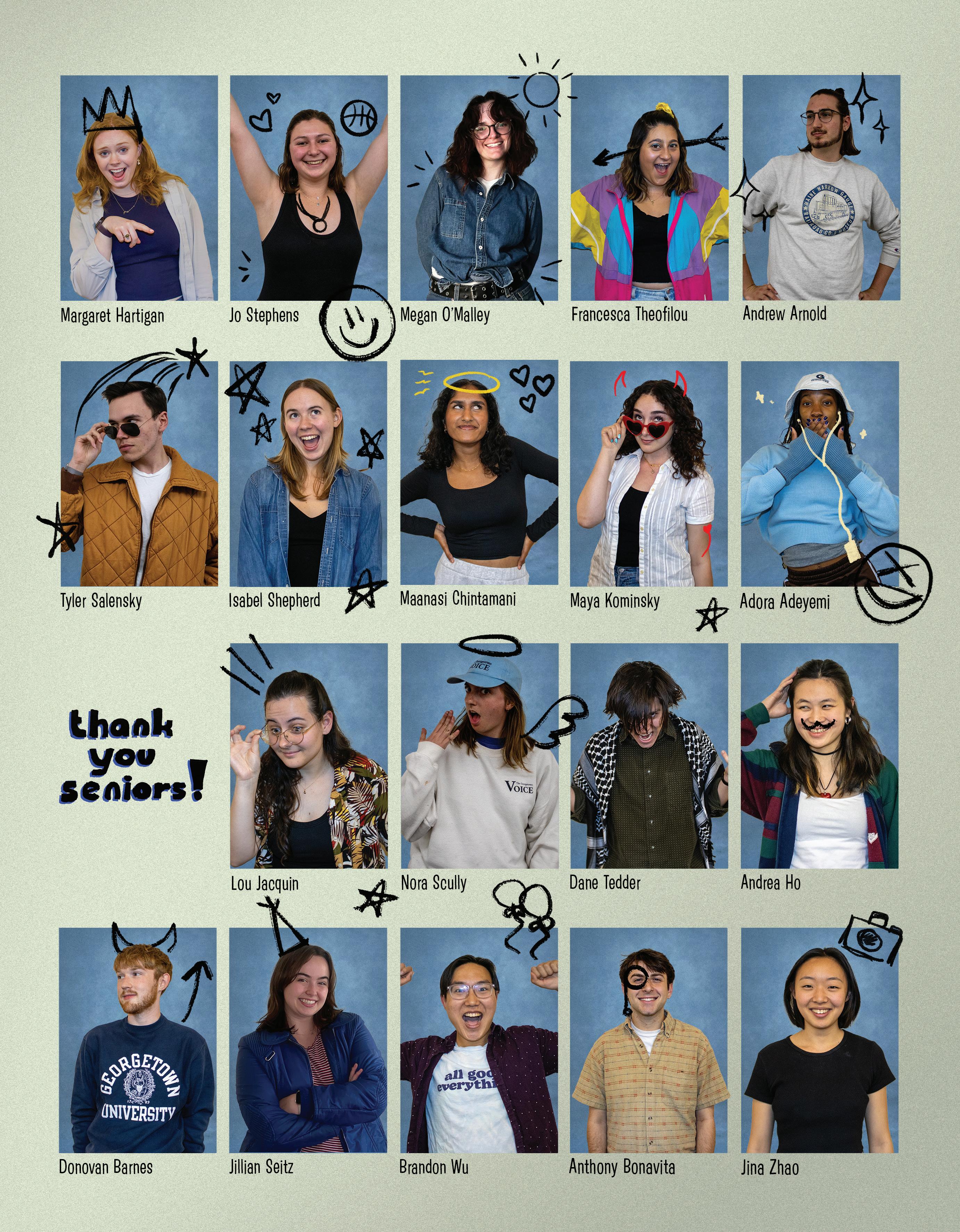




















 BY ANGELENA BOUGIAMAS
BY ANGELENA BOUGIAMAS
































